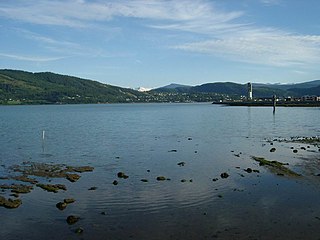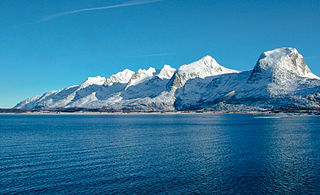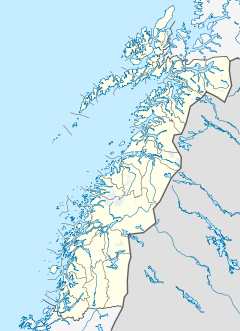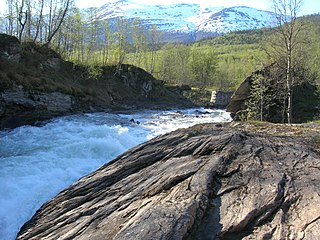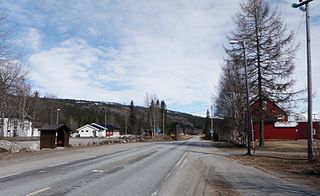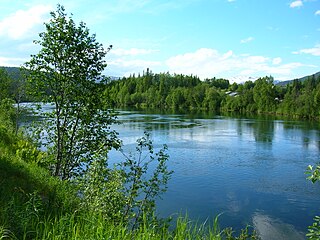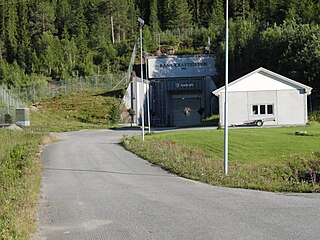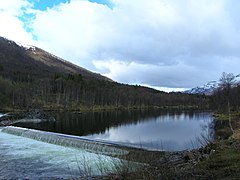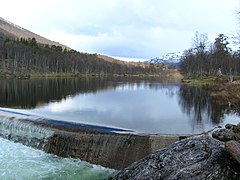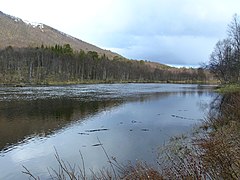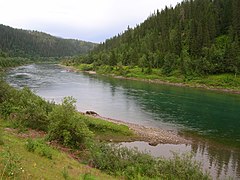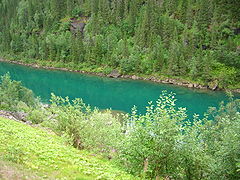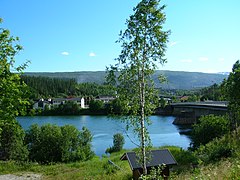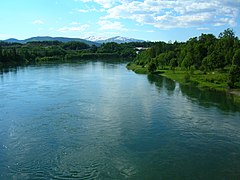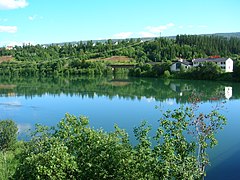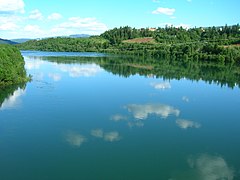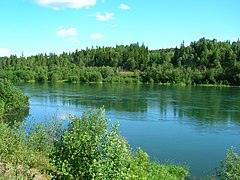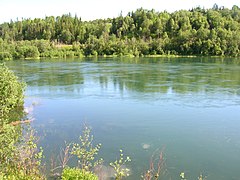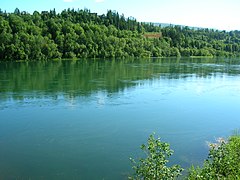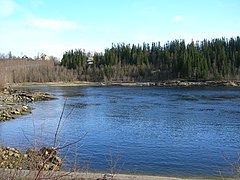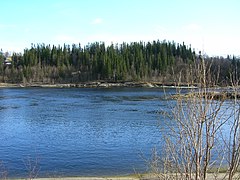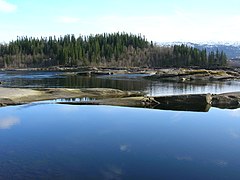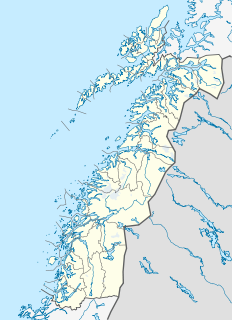
The Ranfjorden is a fjord in the Helgeland district of Nordland county, Norway. The largest part of the fjord is in the municipality of Rana, but the fjord also passes through the municipalities of Hemnes, Vefsn, Leirfjord, Nesna, and Dønna. The river Ranelva meets the Ranfjord in at the town of Mo i Rana at the innermost part of the fjord. It then flows to the west for about 68 kilometres (42 mi) to where it meets the sea along the border of Dønna and Nesna municipalities.

Bogvatnet (Norwegian) or Tjoamodisjávrre (Lule Sami) is a lake in the municipality of Rana in Nordland county, Norway. The lake is located inside the Saltfjellet–Svartisen National Park, about 40 kilometres (25 mi) north of the town of Mo i Rana. The glacial lake is also the headwaters of the Blakkåga river, a tributary to the main river Ranelva.

Kjelvatnet (Norwegian) or Giebbnejávrre or Giebnejávri (Lule Sami) is a lake in Fauske Municipality in Nordland county, Norway. The 3.85-square-kilometre (1.49 sq mi) lake lies about 7 kilometres (4.3 mi) south of the village of Sulitjelma near the border with Junkerdal National Park. Water flows into the lake from the large lake Balvatnet and it flows out of the lake to the north along the Balmi River to the lake Langvatnet.

Langvatnet (Norwegian) or Guhkesjávrre (Lule Sami) is a lake that lies in the municipality of Sørfold in Nordland county, Norway. The 13.97-square-kilometre (5.39 sq mi) lake is located about 30 kilometres (19 mi) northeast of the village of Straumen, just north of Rago National Park and the border with Sweden.

Langvatnet (Norwegian) or Tjoaddnejávrre (Lule Sami) is a lake that lies on the border between Norway and Sweden. Almost all of the lake is located in Tysfjord Municipality in Nordland county, Norway with a very small part of the lake in Jokkmokk Municipality in Norrbotten County, Sweden. The 5.46-square-kilometre (2.11 sq mi) lake is located about 20 kilometres (12 mi) southeast of the village of Kjøpsvik in Tysfjord.
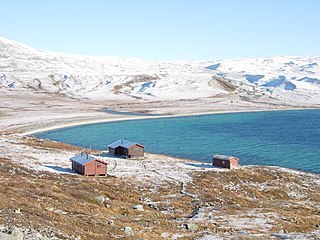
Nordre Bjøllåvatnet (Norwegian) or Bajep Ruovdajávrre (Lule Sami) is a lake that lies in the municipality of Saltdal in Nordland county, Norway. The 9.93-square-kilometre (3.83 sq mi) lake is located inside Saltfjellet–Svartisen National Park, about 1 kilometre (0.62 mi) east of the border with the municipality of Beiarn and north of the border with the municipality of Rana. The lake flows out through the river Bjøllåga and ultimately into the river Ranelva.
Revelelva is the native name of the lowest part of the river Tverråga, which has its outlet in Ranelva in Rana municipality in Nordland county, Norway. The river change its name at the bridge connecting European route E6 with Gruben. Before this bridge it is called Tverråga. Passing this bridge, it is called Revelelva.

Tverråga is a river in the municipality of Rana in Nordland county, Norway. The river flows from lake Tverrvatnet north until it joins the river Ranelva. The river absorbs seven other rivers during its course, the last one by Hamaren near the village of Gruben.

Selfors is a village in the municipality of Rana in Nordland county, Norway. Selfors sits on the northern shore of the river Ranelva and it is a northeastern suburb of the town of Mo i Rana. The European route E06 highway passes through the village. Selfors has been inhabited since the Iron age.

Virvasselva or Virvassåga (Norwegian) or Viresjåhkå (Lule Sami) is a river in the municipality of Rana in Nordland county, Norway. The river flows out of the eastern part of the lake Virvatnet. The stream Boneselva meets Virvasselva about 1 kilometre (0.62 mi) east of the lake Virvatnet. This is a large, continuous, very rich and untouched wetland area with tarns, rivers, marshes, and very tight vegetation. Virvasselva has a good population of Arctic char.

Bolna (Norwegian) or Bållná (Lule Sami) is a mountain in the Saltfjellet mountain range in the municipality of Rana in Nordland county, Norway. The mountain peak reaches 1,460 metres (4,790 ft) above sea level, and is located just north of the Arctic Circle inside Saltfjellet–Svartisen National Park. The mountain peak is located less than 2 kilometres (1.2 mi) west of the municipal border with Saltdal and about 15 kilometres (9.3 mi) west of the border with Sweden.

Ytteren is a village in the municipality of Rana in Nordland county, Norway. Ytteren and the neighboring village of Båsmoen are northern suburbs of the town of Mo i Rana. They are both located on the northern edge of the mouth of the Ranelva river at the Ranfjorden. Norwegian County Road 12 runs through the village. The large lake Langvatnet lies about 2 kilometres (1.2 mi) north of the village.

Gubbeltåga (Norwegian) or Gubbeltædno (Lule Sami) is a river in the municipality of Rana in Nordland county, Norway, which flows in a southern and southwestern direction. The 15-kilometre (9.3 mi) long river begins at the drainage divide on the Saltfjellet plateau in the north. On its direction mainly southwards, it meets and becomes a part of Randalselva, which has its beginning in the Norwegian-Swedish border regions. At Elvmøthei in the Dunderland Valley, Randalselva then meets Virvasselva and thus forms the beginning of Ranelva.

The Balmi River is a river in the municipality of Fauske in Nordland county, Norway. It flows about 6.5 km (4.0 mi) from one lake and empties into another: from Kjelvatnet at an elevation of 510 meters (1,670 ft) north to Langvatnet at an elevation of 127 meters (417 ft). The river has a drainage basin of 439 square kilometers (169 sq mi). The river is located a short distance south of the village of Sulitjelma and about 35 kilometres (22 mi) southeast of the Fauske.
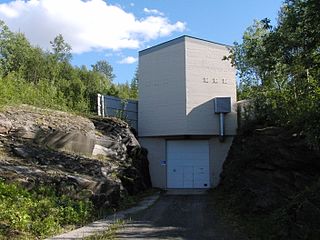
The Daja Hydroelectric Power Station is a hydroelectric power station in the municipality of Fauske in Nordland county, Norway. It is located about 2.3 kilometers (1.4 mi) east-southeast of Jakobsbakken.

The Sundsfjord Hydroelectric Power Station is a hydroelectric power station in the municipality of Gildeskål in Nordland county, Norway. Part of the plant's catchment area also lies in the municipality of Beiarn.

The Langvann Hydroelectric Power Station is a hydroelectric power station in the municipality of Gildeskål in Nordland county, Norway. It is sometimes referred to as the Langvatn kraftverk, which should not be confused with the Langvatn Hydroelectric Power Station in Rana.

